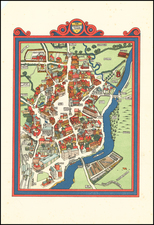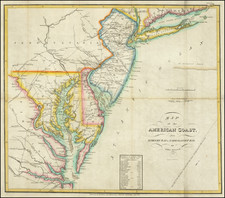The Chief Clerk of the Northwest Territory (and frontier bookseller) Samuel Williams orders books in a letter from the frontier.
A fascinating letter from the western frontier, providing a marvelous image of the many hats warn by prominent Americans of the time period.
The writer, Samuel Williams, is probably best known as one of the early surveyors of Michigan Territory. Williams served in the War of 1812, and thereafter worked for the General Land Office in Washington, D.C., until 1815. From 1815 to 1845, he was chief clerk in the office of the surveyor-general of the Northwest Territory.
The letter mentions Williams dealings with mapmakers Henry Tanner and Anthony Finley, as well as contacts with famed Ohio mapmaker Alexander Bourne (1786-1849). There is also a Col. Brown of Indiana mentioned. This would likely be Colonel Thomas Brown (1780-1840), who lived from 1806 onward in Indian Territory. In the summer of 1819, the surveyor-general appointed him one of the surveyors to survey part of the land recently purchased from the Indians nearly the future Bloomington Indiana, and from 1819 to 1836, he spent a portion of the year doing public survey work.. The last work he did for the government was in Muscatine County, in Iowa Territory.
The text of the letter is as follows:
Bro. Swearingen,
Will be so good as to hand this ??? nd letter to Mr. John McClintock, to whom you delivered a book sent by you to the book agents two years ago. This book has been lost somehow, and I have requested Mr. McClintock to try to recover it.
I have ordered a box of books from N. York which will be delivered to you at Field Forbes & Co. which please bring with your goods.
Please present my respect to my friend Samuel Bell, andsay to him that I received his friendly letter by Mr. Tallman.
Be pleased to procure for me a copy of Adlam's treatise on the vine -- last edition, and also bring mefrom Mr. Tanner a copy of No. 6 of his "American Atlas" for Col. Brown, one of the subscribers in Indiana, to whom I lately gave my own copy of that No. For this and for Adlam on the vien, please to pay out of the money enclosed.
I should be glad if you can procure me a curled hair pillow, as I have a great fancy to sleep with my head cooler than I can on a feather pillow.
If convenient please to ask Mr. Anthony Finley, Bookseller, whether he has yet published his map of the Internal Improvements. And also what discount he would ??? to booksellers who would purchase his maps or atlas' to sell again. For instance, what would he charge me for afew copies ofhis "General Atlas."?
I incluse you $20 U. States money to pay carriage on the books, and to purchase the articles above named.
This will be carried by Col. Bourne, who will probably be in the city as soon as you, as he goes in the stage.
Yours ?? Saml. Williams
Chillicothe 10th Apr. 1829
On the verso are the following notes, most notably the prices which Anthony Finley was offering for what appears to be his wall maps of the US, World, Asia and Europe and his General Atlas:
I have handed Mr. McClintock the letter he tells he ??? have ??? as he has always doneso. Has no recollection of the book.
Map U. States --- 8
Map World -- 7
Map Asia -- 6
Map Europe -- 6
General Atlas -- 10
{6 copies of either one 20 per Cent discount cash. -- 12 copies 25 per cent.
On the outside, with the address, is a note "Friday evening10th Saml. Tells mejust now that your family are all well."
Samuel Williams was born Cumberland, Pennsylvania, the son of Irish immigrants William Williams and Margaret Widney. In 1803, he moved with his father's family to Charleston, in present-day West Virginia, and then to Chillicothe, Ohio, in 1807.
Williams served in the War of 1812, and thereafter worked for the General Land Office in Washington, D.C., until 1815. From 1815-1845, he was chief clerk in the office of the surveyor-general of the Northwest Territory.
From 1829 until his death in 1859, he lived in Cincinnati, Ohio, where he was active in the Methodist Church.
The Samuel Williams papers are held at the University of Michigan and as noted in its online record:
The Samuel Williams papers contain 272 letters, 30 survey records, 11 receipts, 4 maps, 3 ledgers, and a legal document, spanning 1814-1866.
Approximately one-fifth of the correspondence is organized by writer. The John H. Eddy Letters to Samuel Williams series contains three 1817 letters: September 15, concerning John Eddy's comments on drafts of maps of Ohio, Indiana, and Michigan Territory; September 30, regarding a request for corrections to maps using astronomical observations; and December 6, commenting on cartographic scale.
The Samuel Williams Drafts to Lucius Lyon series comprises 20 letters, covering 1841-1849, and containing comments by Williams on cartography and the work of the Surveyor General's Office. Williams wrote to Lyon on such topics as bills concerning his office, surveys in progress, and cartographical issues. On March 3, 1846, he described disagreements within the office, and referred to colleagues' plans to "sabotage" its work. In several other letters postdating 1845, he attempted to tie up loose ends after his resignation; he made ongoing references to missing field notes on Ohio, and to difficulties in establishing the boundary between Michigan and Ohio (March 2, 1847). Williams wrote drafts to several other recipients on the same pages as his drafts to Lyon, and these are also included.
Thirty-one letters make up the Henry S. Tanner Letters to Samuel Williams series , which spans 1818-1836. Letters concern the death of John H. Eddy (August 16, 1818), the exchange of maps of Ohio and Indiana, and the prices and sale of Tanner's publications. On March 3, 1823, Tanner requested assistance in drawing county lines in several states. The letters also document several financial transactions between the men.
Ezekiel S. Haines became surveyor-general in 1838. He wrote 42 letters in the collection between 1838 and 1847, which comprise the Ezekiel S. Haines Letters to Samuel Williams series . The letters are generally brief and business-like, and mainly concern routine office matters such as payroll, business trips, and communications with colleagues.
The Mammoth Cave Drafts and Documents series contains four items: two drafts of narratives of a trip through the cave, and two detailed manuscript maps of the cave. Although the maps are undated and unattributed, the handwriting that appears on them seems to match Williams' own.
The Other Correspondence and Documents series contains 221 items, both incoming and outgoing, spanning 1814-1866. A retained and signed copy of a letter from William Henry Harrison to Edward Tiffin, surveyor general, dated September 16, 1815, reports the signing of a treaty between the United States and members of the Wyandot and other tribes. Harrison commented that "we thought it probable that the Indians did not really understand that the Treaty gave the latitude of location which the words authorized…."
Many of the early letters in this series document the surveying of Michigan, particularly the difficulties of such a task because of fallen brush and timber (December 25, 1817) and unexpected snow (April 30, 1831). Other frequent subjects include updates on surveys in progress of Ohio, Indiana, and Michigan; corrections to maps and atlases; the sale of public land; and comments on Midwestern geography. The most frequent letter writers were Lucius Lyon, who wrote approximately 20 letters; Robert D. Lytle, who contributed approximately 10; John Mullett, who wrote 5; and Samuel Williams himself, who contributed around 10 letters to various recipients. Lyon wrote letters on a number of business topics, including his progress surveying the Michigan Territory (April 30, 1831), soil and minerals in Michigan, business transactions with mutual acquaintances and colleagues, and ongoing issues arising from the transfer of the Office of the Surveyor General from Ohio to Michigan.
The Survey Records series contains 30 undated records for the Michigan Territory, which include latitude and longitude calculations and comments on trees and soil for various areas of the territory. The "Maps" series contains two maps by Alexander Macomb, located in Map Division: [Michigan Territory And the Great Lakes, 1819] and [Saint Mary's River], 1819.











![[Jefferson's Notes on the State of Virginia] Observations sur la Virginie [with the map:] A Map of the country between Albemarle Sound, and Lake Erie, comprehending the whole of Virginia, Maryland, Delaware, and Pensylvania, with parts of several other of the United States of America. Engraved for the Notes on Virginia.](https://storage.googleapis.com/raremaps/img/small/51828.jpg)
![Comparative Size of Lakes and Islands [Great Lakes, Cuba, Formosa, Ireland, Sicily, Cyprus, Vancouver, Sandwich Islands, Puerto Rico, Corsica, Sardinia, Balearics, Malta, etc]](https://storage.googleapis.com/raremaps/img/small/100135.jpg)
![[Appointment of Ben E.S. Ely as Notary Public for Napa County, California - September 26, 1861]](https://storage.googleapis.com/raremaps/img/small/93309.jpg)


![Map of the Main Portion of Pittsburg and Allegheny [with verso] Delaware. Maryland.](https://storage.googleapis.com/raremaps/img/small/84993.jpg)